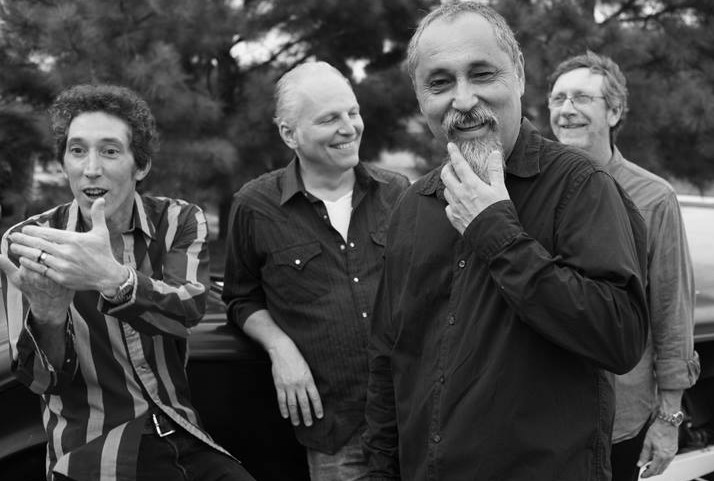
RC: “When I was in high school—this must have been like 1979, 1980—there was hardly anything down on Frenchmen. You had the Dream Palace—that had gone in and out of business for ten years—and that was maybe the original club. Then Snug Harbor opened up, and that’s been in operation this whole time. And then Café Brasil started off at some point but just as a cafe; I don’t think they even had music there at first.
Just to give you a sense of things, I had a friend who had this giant apartment across the street from Café Brasil, catty-cornered, had the entire second floor. Must have been 2,000 square feet up there, and they couldn’t have been paying more than $400 a month or something ridiculous.
Anyway, even as late as when the Iguanas started playing in that early ’90s era, you still just had Snug Harbor and Café Brasil, and maybe Café Istanbul was operating out of that same Dream Palace spot, which again, would go in and out of business. Thankfully nobody ever painted over the ceilings, though; they had this gorgeous mural of the sky, the stars … The Blue Nile. That’s what it is now. Then Café Brasil started having bands, and we started playing there.
On a Mardi Gras day, I used to love to go down to Frenchmen because there’d be hardly any people. But the people that would be down there would be cool. I was with Café Brasil by then—we played there regularly—and I could just go park in front. I could use the restroom, people would buy me drinks … that just gives you some idea of where it was then. It was a very low-key operation.
Evolution & overfishing –
It was a slow evolution, but I’ll tell you what, as to having whatever number of clubs are there right now—20, 25, 30, I can’t even guess—it went from three to six in over ten years. Then six to 12 in the next two years, and then 12 to whatever it is now in the next five years after that.
I don’t know, you felt a certain point where there were suddenly a lot of people that weren’t cool people down there—lot of tourists, a lot of bums… It got really dirty. It got that real sketchy feeling. It wasn’t just a neighborhood spot anymore, a neighborhood New Orleans thing.
This story makes me sound like an old person. But to a certain degree it’s about overfishing. You get certain hunting grounds, and there’s such a thing as overfishing them. I think that may be what’s going on right now. But Bourbon Street eventually got eaten up, and there are still people on there. This will just be the next thing to go through that downward spiral, and there’ll still be commerce.
Tribe Nunzio & The Iguanas
But man, I had some of the greatest times on that street when it was still in that golden era. Bands like Tribe Nunzio would play there—that was before the Iguanas even were a thing—Tribe Nunzio was a big thing. My good friend Jeff Treffinger and a lot of other great musicians. Damon Shea was the drummer in that band, Jeff sang and played guitar, Holden Miller, she was the other singer … Man, those guys, they’d go and black out all the windows with black visqueen at Café Brasil to force everybody to want to come in. We always took the opposite approach with the Iguanas. Like, I want people to be able to see how much fun it looks in here!
At that time, and maybe for the first five years we played there, we’d pack the place every single night. Guaranteed, every time we played there. They had no air conditioning, and it would just be full of people. You’d have to go there with clean clothes on and totally bathed, because you’re going to be soaked to the skin from the first tune; you don’t want to have any funky old clothes on. You got to be nice and fresh.
That’s how it would be. By the end of the first tune, I’d be soaked—like, my jeans would be totally wet to the touch on the outside—and it’s like, well, this is just how I’m going to play the next four hours. This is the state we’re operating in. What are you going to do?
There were a lot of great nights, nights where we’d play super late and more people would just keep showing up. That was the era when Café Brasil was really operating, when Adé was interested in having a club and running it. There weren’t 35 clubs on the street or anything, but a lot of people were still coming down there. That’s my story.”
~~~~~~~~~~~~~~~~
For way more stories about New Orleans bands, characters, and wild times, click HERE to check out René’s podcast, Troubled Men for Troubled Times.
(“René Coman sits down with the original Troubled Man, Manny Chevrolet, over cocktails at the Ring Room, in the heart of an old-school New Orleans social haunt. Manny is an L.A. native who had been through the Hollywood wringer by his late 20s. He then moved to New Orleans to become a perennial candidate for mayor and make a feature film about it. René is a New Orleans native who’s been in the music biz wringer since he was a child. They are the Troubled Men for Troubled Times.”)
